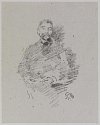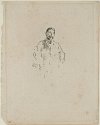Stéphane Mallarmé | ||
| Number: | 462 | |
| Date: | 1891/1892 | |
| Medium: | etching and drypoint | |
| Size: | 229 x 175 mm | |
| Signed: | no | |
| Inscribed: | no | |
| Set/Publication: | no | |
| No. of States: | 1 | |
| Known impressions: | 2 | |
| Catalogues: | K.-; M.-; T.-; W.- | |
| Impressions taken from this plate (2) | ||
KEYWORD
clothing, dress, illustration, man, portrait.
TITLE
There is only one known title:
'Stèphane Mallarmé' (1903/1935, possibly Rosalind Birnie Philip (1873-1958)). 3
The title 'Stèphane Mallarmé' is correct, since it is a portrait of Stéphane Mallarmé (1842-1898).
'Stèphane Mallarmé' (1903/1935, possibly Rosalind Birnie Philip (1873-1958)). 3
The title 'Stèphane Mallarmé' is correct, since it is a portrait of Stéphane Mallarmé (1842-1898).
3: Envelope containing copper plate, Hunterian Art Gallery.
DESCRIPTION
The head and shoulders of a bearded man, Stéphane Mallarmé, turning slightly to the left, wearing a light jacket over a cravat tied loosely around a high collar. The back of his head is reflected in a mirror to his right. The base of a pillar is seen behind him, to left.
SITTER
Stéphane Mallarmé (1842-1898). Whistler met Mallarmé in 1888. This is one of several portraits by Whistler of the poet.
Mallarmé had posed for several graphic portraits, which were published as frontispieces to various works. Félicien Joseph Victor Rops (1833-1898) had made a portrait of Mallarmé for a volume published by Edouard Dujardin in 1887. Marcellin-Gilbert Desboutin (1823-1902) engraved a portrait for Mallarmé's Villiers de L'Isle Adam in 1892. Whistler met Desboutin in 1892, and owned a copy of this book, printed on Asian paper. 4
4: S. Mallarmé, Les miens. I. Villiers de l'Isle-Adam, Brussels: Lacomblez, 1892; GUL Sp Coll Whistler 85.
Eventually Mallarmé posed for Whistler, who tried out portraits in etching, drypoint and lithography. One lithograph, Stéphane Mallarmé, No. 2 [c059] (reproduced above), was completed by 27 October 1892 and the other, Stéphane Mallarmé [c060] (reproduced below) by 30 November 1892. 5
5: Spink 1998, pp. 205-07, cat. nos. 59-60.

Stéphane Mallarmé [c060].
This was then reproduced as the frontispiece for Vers et prose in 1893. 6 Mallarmé was delighted with Whistler's lithographic portrait, writing, 'This portrait is a marvel, the best thing that has ever been done of me, and I am delighted with it.' 7
Whistler later wrote of the lithograph, 'It is very beautiful - and as a portrait of the poet extraordinary'. 8
6: S. Mallarmé, Vers et prose; morceaux choisis, Paris: Perrin, 1893.
7: Mallarmé to Whistler, [5 November 1892], GUW #03857; Barbier 1964, p. 188, no. cvii.
8: Whistler to T. Way, [15 October 1894], GUW #03388.
Another friend of Mallarmé, Paul Gauguin (1848-1903), regularly attended his 'Mardis' (Tuesday salons in the Rue de Rome), as did Whistler. Gauguin made a portrait of Mallarmé in 1891, in which he used etching, aquatint, open-bite and drypoint, printing a few proofs then and more in Paris in 1894. It shows the poet with a raven in the shadows behind him, a reference to Mallarmé's translation of the poems of Edgar Allen Poe, with illustrations by Edouard Manet (1832-1883).
DISCUSSION
In 1891 Gabriel Mourey (1865-1943) published 'Devant le miroir', a translation of the poem by Algernon Charles Swinburne (1837-1909) about Symphony in White, No. 2: The Little White Girl [y052]. In Whistler's famous painting, Joanna Hiffernan (b. ca 1843) is shown reflected in a mirror. The image may therefore have been in Whistler's and in Mallarmé's mind when deciding on a pose and setting for this portrait. 9
9: Gabriel Mourey, Poemes et ballades de A. C. Swinburne, Paris, 1891, pp. 166-67.
Whistler's etching is evocative of the poet and his reflective, suggestive, symbolic poetry. The inclusion of a reflection, the pillar, the flickering, fading lines of drypoint, the lack of clarity, can be taken as allusions to Mallarmé's complex poetry.

